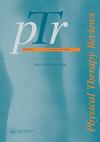物理治疗中疼痛的生物心理社会模型:过去、现在和未来
IF 0.8
Q4 REHABILITATION
引用次数: 2
摘要
摘要背景疼痛的生物-心理-社会模型可能有助于理解疼痛及其临床表现。目的本文对物理疗法中疼痛的生物心理社会模型的过去、现在和未来进行了讨论。主要发现疼痛的生物-心理-社会模型承认人们疼痛体验的动态、相互依存的生物、心理和社会维度,并得到了广泛认可。然而,生物心理社会模型并非无可挑剔,其在临床实践中的适用性也受到了质疑。研究人员调查了临床医生如何在临床实践中理解和应用生物心理社会模型。有证据表明,理疗师对其以心理社会为导向的临床知识和实践表现出不同程度的信心和熟练程度。已经对心理知情的物理治疗方法进行了描述和试验,并显示出与患者相关的结果和效果大小不一致。此外,评论人士认为,该模型的“社会”维度被相对忽视了。虽然有一些证据表明生物心理社会模型正在发展,并且正在努力开发和验证临床应用工具,教育工作者和研究人员已被邀请考虑在临床实践中实施生物心理社会模型的现有障碍和推动者,以提高其在医疗保健中的理解和应用。结论生物-心理-社会模型使临床医生能够理解和解决患者疼痛的生物学、心理学和社会维度。物理治疗中疼痛的生物-心理-社会模型的理解和实施是喜忧参半的。改善教育和培训,制定和评估创新的生物-心理-社会干预措施似乎是重要的前进方向。疼痛的生物-心理-社会模型随着科学和临床的发展而不断发展。本文章由计算机程序翻译,如有差异,请以英文原文为准。
The biopsychosocial model of pain in physiotherapy: past, present and future
Abstract Background The biopsychosocial model of pain may aid the understanding pain and its clinical presentations. Objectives This paper presents a discussion of the past, present and future state of the biopsychosocial model of pain within physiotherapy. Main Findings The biopsychosocial model of pain acknowledges the dynamic interdependent biological, psychological and social dimensions of peoples pain experiences and has been widely endorsed. However, the biopsychosocial model is not beyond criticism and its applicability to clinical practice has been questioned. Researchers have investigated how clinicians understand and apply the biopsychosocial model in clinical practice. Evidence suggests that physiotherapists demonstrate varying levels of confidence and proficiency in their psychosocially-oriented clinical knowledge and practice. Psychologically informed physiotherapy treatment approaches have been described and trialled and show inconsistent results and effect sizes with respect to patient-related outcomes. In addition, commentators suggest that the ‘-social’ dimension of the model has been relatively neglected. While there is some evidence that the biopsychosocial model is evolving, and efforts are underway to develop and validate clinically-applicable tools, physiotherapy clinicians, educators and researchers have been invited to consider existing barriers and enablers to the implementation of the biopsychosocial model in clinical practice in order to improve its understanding and application within healthcare. Conclusion The biopsychosocial model invites clinicians to understand and address the biological, psychological, and social dimensions of patients pain. Understanding and implementation of the biopsychosocial model of pain in physiotherapy is mixed. Improving education and training and developing and evaluating innovative biopsychosocial-oriented interventions appear to be important ways forward. The biopsychosocial model of pain is evolving in response to scientific and clinical developments.
求助全文
通过发布文献求助,成功后即可免费获取论文全文。
去求助
来源期刊

Physical Therapy Reviews
REHABILITATION-
CiteScore
1.30
自引率
0.00%
发文量
26
期刊介绍:
Physical Therapy Reviews is an international journal which aims to publish contemporary reviews, discussion papers and editorials within physical therapy, and in those basic and clinical sciences which are the basis of physical therapy. The journal is aimed at all those involved in research, teaching and practice within the area of physical therapy. Reviews (both descriptive and systematic) are invited in the following areas, which reflect the breadth and diversity of practice within physical therapy: •neurological rehabilitation •movement and exercise •orthopaedics and rheumatology •manual therapy and massage •sports medicine •measurement •chest physiotherapy •electrotherapeutics •obstetrics and gynaecology •complementary therapies •professional issues •musculoskeletal rehabilitation
 求助内容:
求助内容: 应助结果提醒方式:
应助结果提醒方式:


